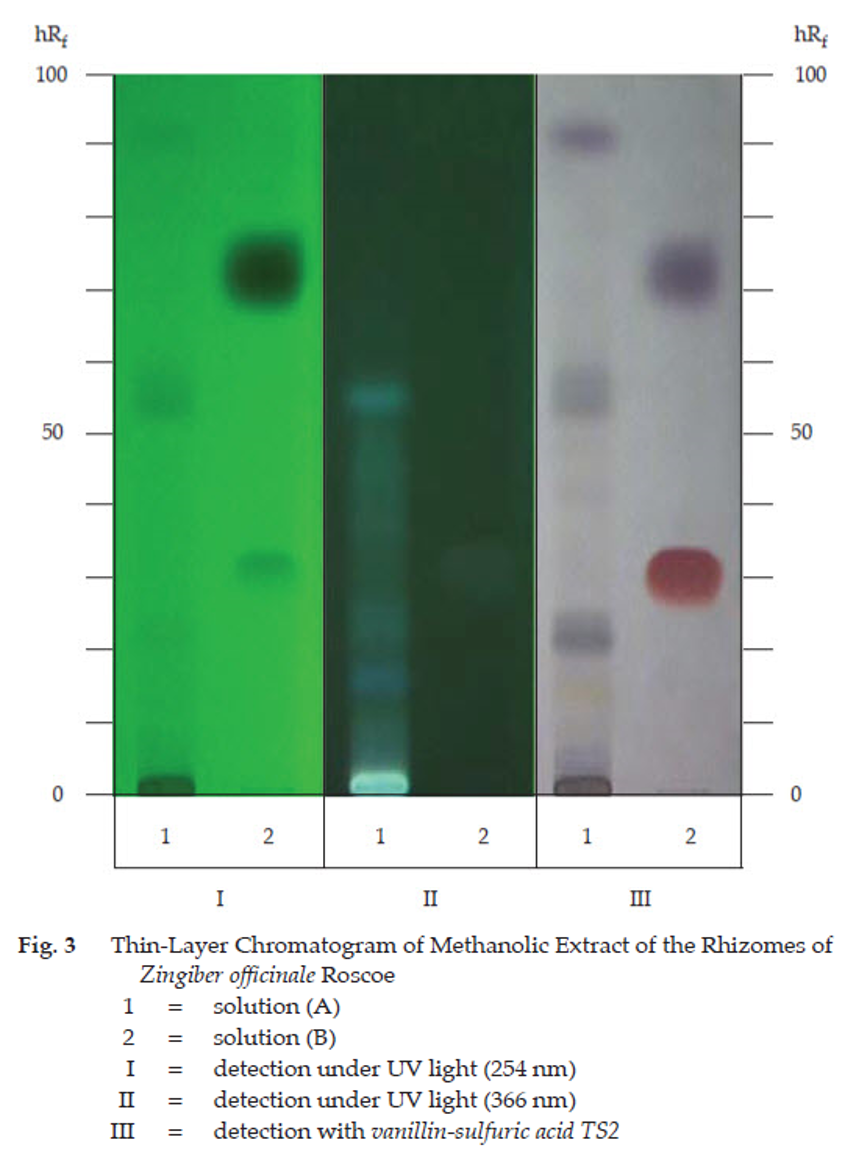ตำรามาตรฐานยาสมุนไพรไทย
Thai Herbal Pharmacopoeia
สำนักยาและวัตถุเสพติด กรมวิทยาศาสตร์การแพทย์ กระทรวงสาธารณสุข
Bureau of Drug and Narcotic, Department of Medical Sciences, Ministry of Public Health(Tinospora crispa (L.) Hook.f. & Thomson)
(Nelumbo nucifera Gaertn.)
(Centella asiatica (L.) Urb.)
(Centella Dry Extract)
(Centella Cream)
(Mesua ferrea L.)
(Piper sarmentosum Roxb.)
(Piper sarmentosum Roxb.)
(Pterocarpus santalinus L. f.)
(Santalum album L.)
(Senna tora (L.) Roxb.)
(Senna alata (L.) Roxb.)
(Senna Alata Tea)
(Piper retrofractum Vahl)
(Myristica fragrans Houtt)
(Andrographis paniculata (Burm. f.) Nees)
(Andrographis Capsules)
(Allium ascalonicum L.)
(Ocimum tenuiflorum L.)
(Curcuma longa L.)
(Turmeric Capsules)
(Turmeric Dry Extract)
(Turmeric Dry Extract Capsules)
(Arcangelisia flava (L.) Merr.)
(Curcuma sp.)
Harrisonia perforata (Blanco) Merr.
(Aristolochia pierrei Lecomte)
(Zingiber officinale Roscoe)
(Ginger Capsules)
(Ginger Tea)
(Cassia fistula L.)
(Nardostachys jatamansi (D. Don) DC.)
(Angelica sinensis (Oliv.) Diels)
Artemisia annua L.
(Ligusticum sinense Oliv. cv. Chuanxiong)
(Neopicrorhiza scrophulariiflora Pennell)
(Atractylodes lancea (Thunb.) DC.)
(Aucklandia lappa Decne)
(Terminalia chebula Retz.)
(Angelica dahurica (Hoffm.) Benth. & Hook. f. ex Franch. & Sav. var. dahurica)
(Kaempferia parviflora Wall. ex Baker)
(Hibiscus sabdariffa L.)
(Roselle Tea)
(Allium sativum L.)
(Zingiber zerumbet (L.) Sm.)
(Wurfbainia testacea (Ridl.) Škorničk.& A. D. Poulsen)
(Cannabis sativa L.)
(Myristica fragrans Houtt)
(Dracaena cochinchinensis (Lour.) S. C. Chen)
(Ficus racemosa L.)
(Hyptis suaveolens (L.) Poit.)
Clerodendrum indicum (L.) Kuntze
(Phyllanthus emblica L.)
(Citrus hystrix DC.)
(Citrus hystrix DC.)
(Areca catechu L.)
(Momordica charantia L.)
Moringa oleifera Lam.
(Aegle marmelos (L.) Corrêa)
(Solanum trilobatum L.)
(Morus alba L.)
Gynostemma pentaphyllum(Thunb.)
Makino
(Clinacanthus nutans (Burm. f.) Lindau)
(Cissus quadrangularis L.)
(Mimusops elengi L.)
(Zingiber montanum (J. König) Link. ex A. Dietr.)
(Piper betle L.)
(Capsicum annuum L.)
(Capsicum Oleoresin)
(Capsicum Gel)
(Piper nigrum L.)
(Piper nigrum L.)
(Eurycoma longifolia Jack)
(Thunbergia laurifolia Lindl.)
(Piper wallichii (Miq.) Hand.-Mazz.)
Senna garrettiana (Craib) H. S. Irwin & Barneby
(Terminalia bellirica (Gaertn.) Roxb.)
(Terminalia chebula Retz.)
(Caesalpinia bonduc (L.) H. Roxb.)
(Tarlmounia elliptica (DC.) H. Rob., S. C. Keeley, Skvaria & R. Chan)
(Hog Creeper Vine Dry Extract Capsiles)
(Hog Creeper Vine Dry Extract)
(Brachypterum scandens (Roxb.) Miq.)
(Lepidium sativum L.)
(Nigella sativa L.)
(Cuminum cyminum L.)
(Foeniculum vulgare Mill.)
(Plantago ovata Forssk.)
(Pimpinella anisum L.)
(Carum carvi L.)
(Anethum graveolens L.)
(Trachyspermum ammi (L.) Sprague)
Albizia procera (Roxb.) Benth.
(Acorus calamus L.)
(Tiliacora triandra (Colebr.) Diels)
Cyanthillium cinereum (L.) H. Rob.
(Orthosiphon aristatus (Blume) Miq.)
Murdannia loriformis (Hassk.) R. S. Rao & Kammathy
(Capparis micracantha DC.)
(Chrysopogon zizanioides (L.) Roberty)
(Cyperus rotundus L.)
(Cannabis sativa L.)
(Syzygium aromaticum (L.) Merr. & L. M. Perry)
(Boesenbergia rotunda (L.) Mansf.)
(Acanthus ebracteatus Vahl)
(Acanthus ilicifolius L.)
(Kaempferia galanga L.)
(Curcuma comosa Roxb.)
Betula alnoides Buch.-Ham. ex D. Don
Cannabis sativa L.
Carthamus tinctorius L
Mitragyna speciosa (Korth.) Havil
Mallotus repandus (Rottler) Müll. Arg
Azadirachta indica A. Juss. var. siamensis Valeton
Azadirachta indica A. Juss. var. siamensis Valeton
Punica granatum L.
Rhinacanthus nasutus (L.) Kurz
Baliospermum solanifolium (Burm.) Suresh
Curcuma aeruginosa Roxb
Boesenbergia kingii Mood & L. M. Prince
Senegalia rugata (Lam.) Britton & Rose
Acacia concinna (Willd.) DC.
Senegalia rugata (Lam.) Britton & Rose
Acacia concinna (Willd.) DC.
Senna alexandriana Mill. var. alexandriana
Cassia acutifolia Delile, Cassia angustifolia Vahl
Butea superba Roxb. ex Willd.
[Plaso superba (Roxb. ex Willd.) Kuntze, Rudolphia superba (Roxb. ex Willd.) Poir.
Pueraria candollei Graham
ex Benth. var. mirifica (Airy Shaw & Suvat.) Niyomdham
Streblus asper Lour.
Suregada multiflora (A. Juss.) Baill. (Gelonium
multiflorum A. Juss.
Plumbago zeylanica L.
Plumbago indica L.
Biancaea sappan (L.) Tod.
Ziziphus attopensis Pierre
Streblus asper Lour.
Justicia gendarussa Burm. f.
Enhalus acoroides (L. f.) Royle
Bridelia ovata Decne.
Tamarindus indica L.
Citrus × aurantiifolia (Christm.) Swingle
Garcinia mangostana L.
Blumea balsamifera (L.) DC
Persicaria odorata (Lour.) Soják
Zingiber montanum (J. König) Link ex A. Dietr.
Mammea siamensis (Miq.) T. Anderson
Citrus maxima (Burm.) Merr.
Citrus × aurantium L. ‘Som Sa’
Punica granatum L.
Rhinacanthus nasutus (L.) Kurz
Ginger is the dried rhizome of Zingiber officinale Roscoe (Amomum zingiber L.) (Family Zingiberaceae), Herbarium Specimen Number: BKF 193777, Crude Drug Number: DMSc 1145.
Constituents Ginger contains oleoresin predominantly consisting of gingerols, shogaols and volatile oil. Its volatile oil comprises zingiberene, borneol, geraneol, etc. It also contains fatty acids, starch, etc.
Description of the plant (Figs. 1a, 1b) Perennial herb; pseudostem up to 2 m tall, leafy; subterraneous rhizome branched, thick, fleshy, yellowish inside, strongly aromatic. Leaves simple, alternate, sessile, lanceolate or linear-lanceolate, 10 to 30 cm long, 1.5 to 3 cm wide, apex acute or acuminate, base obtuse, sheathing; ligule membranous, 2 to 4 mm long, bilobed. Inflorescence arising from rhizome, spike elliptic to oblong, 4 to 9 cm long, 2 to 3 cm wide; peduncle erect, up to 25 cm long, with 5 to 9 green sheaths; bract imbricate, free, green, incurved, globose, obrhombic or obovate, 2 to 3 cm long, 2 to 2.5 cm wide, apex obtuse, glabrous on both sides, cream to creamy yellow on margin and tip, sharp apex tip; bracteole elliptic-oblong, cirrated, 2.5 to 2.8 cm long, 1 to 1.5 cm wide, apex obtuse or teethed, glabrous; corolla tube 3-lobed, 2.2 to 2.5 cm long, glabrous, white, dorsal lobe 1.7 to 1.8 cm long, about 8 mm wide, lateral lobes 1.6 to 1.7 cm long, 4 to 5 mm wide; labellum conspicuously 3-lobed, midlobe rounded or obovate, about 1.6 cm long, 1.3 to 1.4 cm wide, apex truncate or emarginate, dark red with yellow blotches at base, side lobes about 7 mm long, 5 to 6 mm wide, apex acute, dark red with scattered creamy dots; anther about 1 cm long, about 3 mm wide, filament about 3 mm long, flattened, appendage 7 to 9 mm long, apex acute, dark red; stylode unequal, 7 to 8 mm long; ovary inferior, glabrous, 3-loculed, each locule with several ovules. Fruit capsule, oblong. Seeds numerous, blackish, arillate.
Description Odour, characteristic and aromatic; taste, pungent and aromatic
Macroscopical (Fig. 1a) Unpeeled, horizontal, irregularly branched and vary in size. Externally light brown with longitudinal wrinkles and distinct annulated nodes; branched parts usually with remains of scale leaves, apex with stem scars or buds. Texture compact, fibrous; fracture yellowish to brownish.
Microscopical (Figs. 2a, 2b) Transverse section of the rhizome shows epidermis, storied cork, cortex, pseudoendodermis, and vascular bundles. Epidermis, a layer of thin-walled rectangular cells. Storied cork, layers of thin-walled, suberinized rectangular cells. Cortex, thin-walled parenchyma cells containing numerous starch grains and/or oil globules, some of which containing yellow oleoresin. Pseudoendodermis, a layer of small thin-walled rectangular cells. Vascular bundles, scattered in cortex, containing xylem and phloem tissues; vessels, mostly scalariform and reticulate.
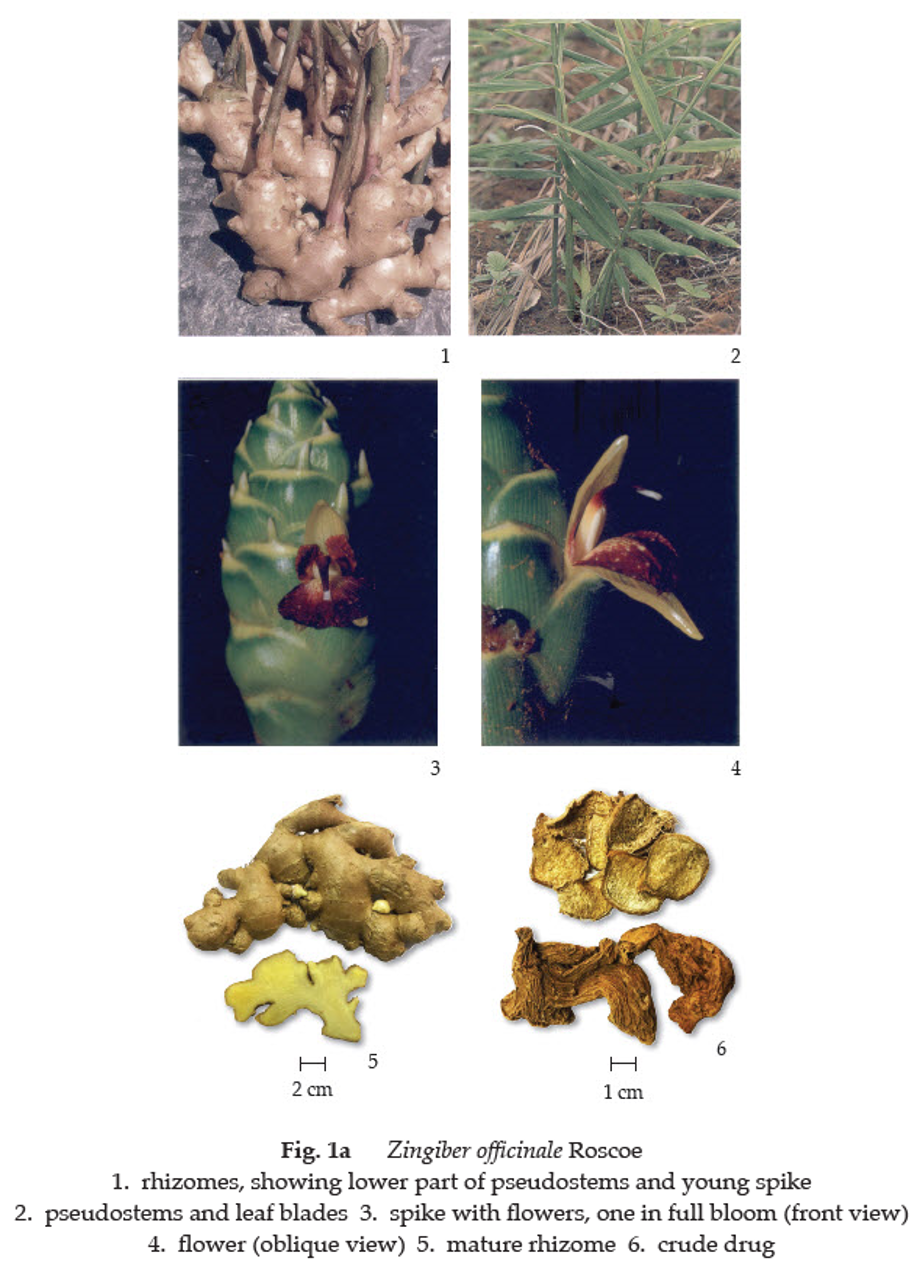
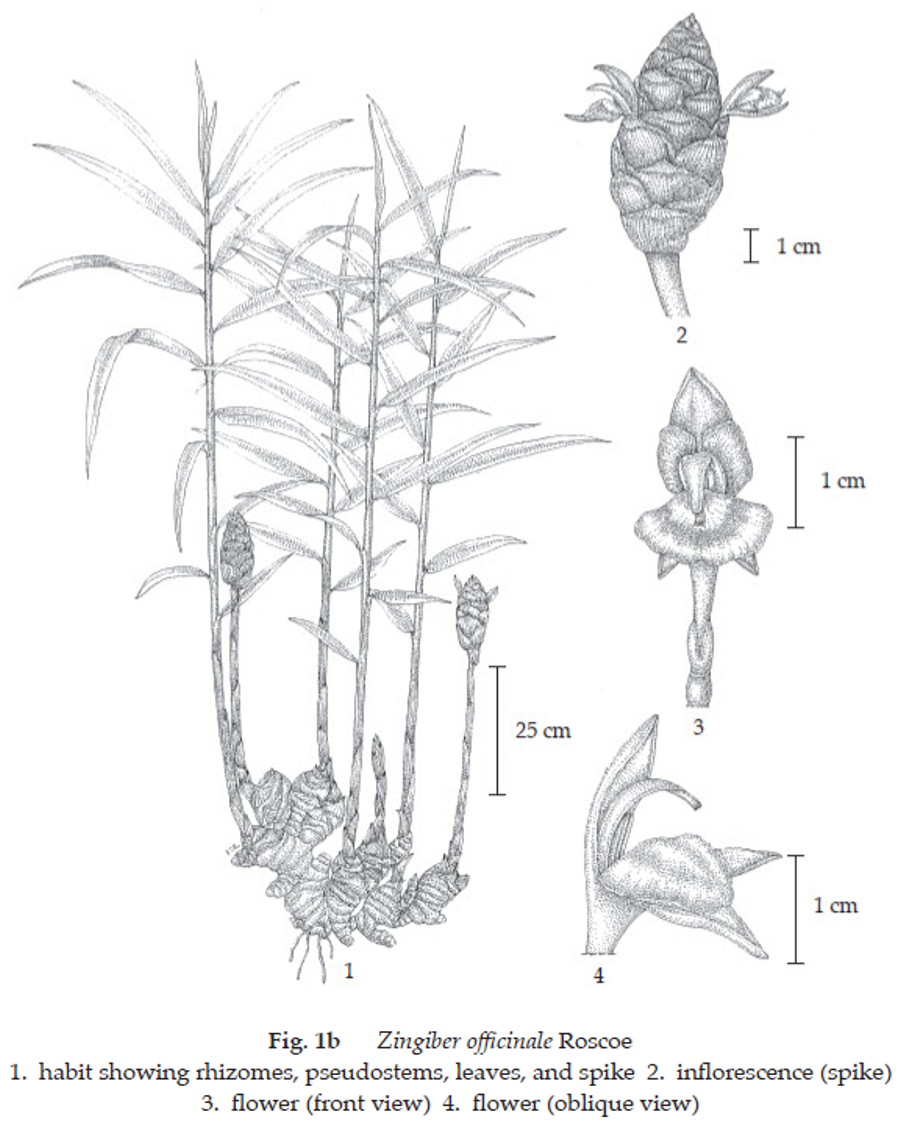
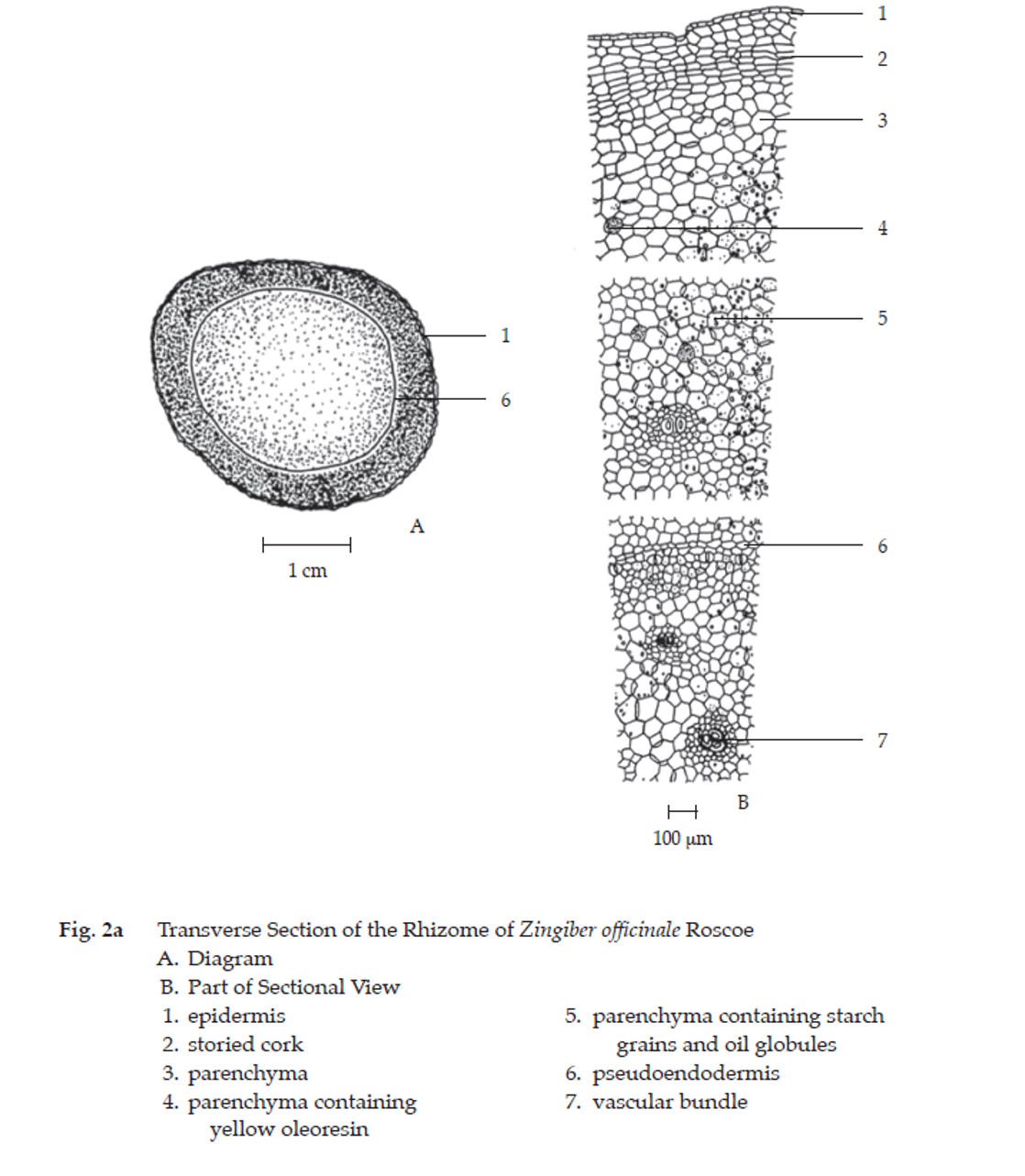
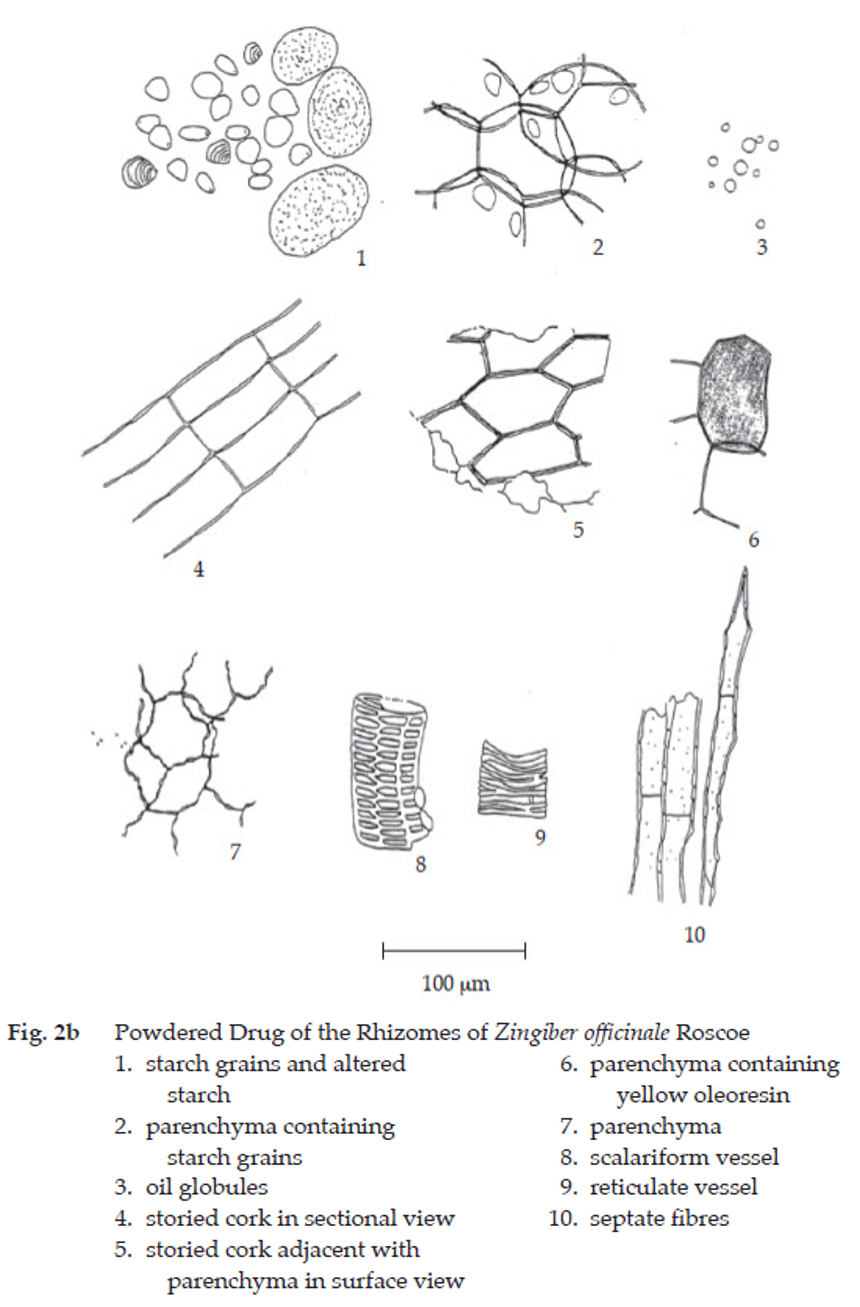
Ginger in powder possesses the diagnostic microscopical characters of the unground drug. Layers of thin-walled cells of storied cork, parenchyma containing starch grains, and/ or altered starch, and/or yellow oleoresin are characteristic.
Warning
1. It should not be used in children under 6 years of age and in pregnant women.
2. It should not be used in patients with bile duct obstruction except under medical supervision.
3. Concomitant use with anticoagulants and antiplatelets should be used with caution.
Additional information Ginger containing not less than 2 per cent v/w of volatile oil can be administered orally as an anti-emetic.
Packaging and storage Ginger shall be kept in well-closed containers, preferably of metal or glass, protected from light and stored in a cool and dry place.
Identification
A. Dissolve 50 mg of the residue obtained from Ethanol-soluble extractive in 25 mL of water and extract this solution with two 15-mL portions of ether. Combine the ether extracts and evaporate to dryness. To the residue, add 5 mL of a 75 per cent v/v solution of sulfuric acid, and 5 mg of vanillin and then mix well. Allow to stand for 15 minutes and add 5 mL of water: a bright blue colour develops.
B. To 1 g of the sample, in powder, add 5 mL of a 50 per cent v/v solution of glacial acetic acid. Shake vigorously for 15 minutes and filter. To the filtrate, add a few drops of ammonium oxalate TS: a slight turbidity is produced.
C. Carry out the test as described in the “Thin-Layer Chromatography” (Appendix 3.1), using silica gel GF254 as the coating substance and a mixture of 40 volumes of hexane and 60 volumes of ether as the mobile phase. Apply separately to the plate as bands of 15 mm, 20 μL each of the following two solutions. Prepare solution (A) by shaking 1 g of the sample, in powder, with 5 mL of methanol for 15 minutes and filtering. For solution (B), dissolve 10 μL of citral and 10 mg of resorcinol, as the reference compounds1, in 10 mL of methanol. After removal of the plate, allow it to dry in air and examine under ultraviolet light (254 nm), marking the quenching bands. The chromatogram obtained from solution (A) shows three quenching bands. Two quenching bands are between the bands due to resorcinol (hRf value 30 to 33) and citral isomers (hRf values 70 to 72 and 73 to 75) in the chromatogram obtained from solution (B) and one quenching band is below the resorcinol band. Examine the plate under ultraviolet light (366 nm) through the cut-off filter; one blue and several green-blue fluorescent bands are observed. Spray the plate with vanillin-sulfuric acid TS2 and heat at 105° for 10 minutes. The chromatogram obtained from solution (A) shows one violet-grey, one brown-yellow and two violet bands below the red band due to resorcinol in the chromatogram obtained from solution (B). It also shows one dark violet band above the two violet bands due to citral isomers in the chromatogram obtained from solution (B) and two violet-grey and two violet bands between the bands due to resorcinol and citral isomers (Table 1); see also Fig. 3.
1Citral and Resorcinol are not marker compounds for Ginger. They are used as the reference compounds for the purpose of TLC identification.
Table 1 hRf Values of Components in Methanolic Extract of the Rhizomes of Zingiber officinale Roscoe
| Band | hRf Values | Detection | ||
| UV 254 | UV 366 | Vanillin-Sulfuric Acid TS2 | ||
| 1 2 3 4 5 6 7 8 9 10 11 |
4-5 13-15 20-22 23-25 35-37 42-43 44-46 47-49 53-55 57-58 90-92 |
- - weak quenching - - - - - quenching quenching - |
- blue green-blue green-blue green-blue - green-blue - green-blue - - |
violet-grey brown-yellow violet violet - pale violet - pale violet violet-grey violet-grey dark violet |
Water Not more than 11.0 per cent v/w (Azeotropic Distillation Method, Appendix 4.12).
Foreign matter Not more than 2.0 per cent w/w (Appendix 7.2).
Acid-insoluble ash Not more than 1.0 per cent w/w (Appendix 7.6).
Total ash Not more than 10.0 per cent w/w (Appendix 7.7).
Water-soluble ash Not less than 3.0 per cent w/w (Appendix 7.11).
Ethanol-soluble extractive Not less than 5.0 per cent w/w (Appendix 7.12).
Water-soluble extractive Not less than 13.0 per cent w/w (Appendix 7.12).
Volatile oil Not less than 0.8 per cent v/w, calculated on the anhydrous basis (Appendix 7.3H). Use 50 g, in coarse powder, freshly prepared and accurately weighed. Use 200 mL of water as the distillation liquid and a 500-mL round-bottomed flask. Distil at a rate of 3 mL per minute for 5 hours. Use 2.0 mL of xylene in the graduated tube.
Dose 2 to 4 g a day
